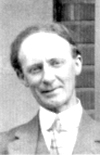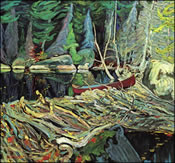J.E.H. MACDONALD
1873 - 1932
 J.E.H.
MacDonald together with Lawren Harris constituted the driving force
and inspiration in the formation of The Group of Seven. They held
similar strong beliefs in the direction and ideals of art in Canada,
and MacDonald often found himself spokesman for the new artistic movement.
While The Group of Seven was considered to be radical for its time,
at age forty-seven when The Group formed, MacDonald could hardly be
referred to as a "young radical".
J.E.H.
MacDonald together with Lawren Harris constituted the driving force
and inspiration in the formation of The Group of Seven. They held
similar strong beliefs in the direction and ideals of art in Canada,
and MacDonald often found himself spokesman for the new artistic movement.
While The Group of Seven was considered to be radical for its time,
at age forty-seven when The Group formed, MacDonald could hardly be
referred to as a "young radical".
Born in England, MacDonald emigrated to Canada as a teenager with his family and studied art in Hamilton. The oldest member of The Group of Seven, he began work at the Toronto firm of Grip Ltd. MacDonald became Grip's art director and today is well known for his superlative commercial design work. He supervised the work of fellow artists Frank Johnston, Tom Thomson, Arthur Lismer and Franklin Carmichael. His interest in landscape painting involved him in Grip's weekend sketching trips as well as several other sketching clubs in Toronto.
In 1911, MacDonald moved his wife and family to Thornhill, Ontario, quit his job and began painting full-time. Here he found inspiration from the surrounding countryside. In the next few years he began to travel north - first to the Georgian Bay area and then to Algonquin Park. The appeal of the north was very strong for both MacDonald and his good friend Tom Thomson. Thomson and MacDonald are considered to have had tremendous impact on each other's work. After Thomson's death in 1917, MacDonald suffered a physical collapse and possibly a stroke while working at the memorial cairn at Canoe Lake in Algonquin Park. He was bedridden for several months.
 In 1918 Harris prevailed upon MacDonald to join their now famous boxcar
trips to the Algoma region north of Lake Superior. In Algoma MacDonald
received his greatest inspiration. For the next five years he entered
his most productive phase of painting. Algoma became known as "MacDonald's
country". His works from this period show rich colours and bold treatment,
ranging from closer, more intimate views of nature to more complicated
landscapes.
In 1918 Harris prevailed upon MacDonald to join their now famous boxcar
trips to the Algoma region north of Lake Superior. In Algoma MacDonald
received his greatest inspiration. For the next five years he entered
his most productive phase of painting. Algoma became known as "MacDonald's
country". His works from this period show rich colours and bold treatment,
ranging from closer, more intimate views of nature to more complicated
landscapes.
Financially unable to remain a freelance commercial designer, MacDonald returned to full-time employment in 1922 as a teacher at the Ontario College of Art. His major sketching trips were from then on confined to mostly school holidays. MacDonald continued to be a mainstay and stabilizing force for the members of The Group of Seven. He suffered a stroke in 1931 and took a convalescent trip to Barbados in early 1932. He died late that autumn. His death, following the formal disbanding of The Group in 1931, signalled the end of The Group of Seven years.
To those who did not know him well, MacDonald, the oldest member of The Group of Seven, appeared to be a quiet and shy family man of frail stature with the dreamy air of a poet and philosopher. Underneath, he was a practical man who had great strength of character and was respected by the other artists as a father figure. His influence on other artists and his role in the development of The Group of Seven are of profound importance. His nature, both poetic and outspoken, is reflected in his dedicated professionalism in all aspects of his career - his commercial art, his teaching, his writing, and, of course, his individualistic interpretation of the beautiful and the monumental in the Canadian landscape.
Sources: The National Gallery and 'The McMichael Collection'